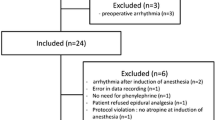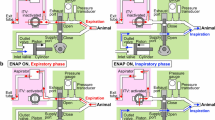Abstract
Phenylephrine is an α1-adrenergic receptor agonist widely used to treat perioperative hypotension. Its other hemodynamic effects, in particular on preload and contractility, remain controversial. We, therefore, investigated the effect of continuously applied phenylephrine on central hemodynamics in eight mechanically ventilated domestic pigs. Mean arterial pressure (MAP) was increased in steps by 50%, and 100% using phenylephrine. Besides stroke volume (SV), cardiac output (CO), and MAP, mean systemic vascular resistance (SVR) and dynamic arterial elastance (Eadyn) were assessed for characterization of afterload. Changes in preload were assessed by central venous pressure (CVP), global end-diastolic volume (GEDV), mean systemic filling pressure analog (Pmsfa), pulse pressure variation (PPV), and stroke volume variation (SVV). Further, cardiac function index (CFI), global ejection fraction and dPmax were measured as markers of preload dependent contractility. MAP, SV, and CO significantly increased following both interventions, as did SVR. In contrast, Eadyn did not show significant changes. Although the volumetric preload variable GEDV increased after the first step of phenylephrine, this was not reflected by significant changes in CVP or Pmsfa. CFI and dPmax significantly increased after both steps. Phenylephrine does not only affect cardiac afterload, but also increases effective preload. In contrast to CVP and Pmsfa, this effect can be monitored by GEDV. Further, phenylephrine affects contractility.



Similar content being viewed by others
References
Michard F, Giglio MT, Brienza N. Perioperative goal-directed therapy with uncalibrated pulse contour methods: impact on fluid management and postoperative outcome. Br J Anaesth. 2017;119:22–30.
Osawa EA, Rhodes A, Landoni G, et al. Effect of perioperative goal-directed hemodynamic resuscitation therapy on outcomes following cardiac surgery: a randomized clinical trial and systematic review. Crit Care Med. 2016;44:724–33.
Goepfert MS, Richter HP, Zu Eulenburg C, et al. Individually optimized hemodynamic therapy reduces complications and length of stay in the intensive care unit: a prospective, randomized controlled trial. Anesthesiology. 2013;119:824–36.
Gan TJ, Soppitt A, Maroof M, et al. Goal-directed intraoperative fluid administration reduces length of hospital stay after major surgery. Anesthesiology. 2002;97:820–6.
Wakeling HG, McFall MR, Jenkins CS, et al. Intraoperative oesophageal Doppler guided fluid management shortens postoperative hospital stay after major bowel surgery. Br J Anaesth. 2005;95:634–42.
Malbrain ML, Marik PE, Witters I, Cordemans C, Kirkpatrick AW, Roberts DJ, Van Regenmortel N. Fluid overload, de-resuscitation, and outcomes in critically ill or injured patients: a systematic review with suggestions for clinical practice. Anaesthesiol Intensive Ther. 2014;46:361–80.
Reuter DA, Chappell D, Perel A. The dark side of fluid loading. Intensive Care Med. 2017 (Epub ahead of print).
Malbrain MLNG, Van Regenmortel N, Saugel B, De Tavernier B, Van Gaal PJ, Joannes-Boyau O, Teboul JL, Rice TW, Mythen M, Monnet X. Principles of fluid management and stewardship in septic shock: it is time to consider the four D’s and the four phases of fluid therapy. Ann Intensive Care. 2018;8:66.
Hjortrup PB, Haase N, Bundgaard H, Thomsen SL, Winding R, Pettilä V, Aaen A, Lodahl D, Berthelsen RE, Christensen H, Madsen MB, Winkel P, Wetterslev J, Perner A, CLASSIC Trial Group; Scandinavian Critical Care Trials Group. Restricting volumes of resuscitation fluid in adults with septic shock after initial management: the CLASSIC randomised, parallel-group, multicentre feasibility trial. Intensive Care Med. 2016;42:1695–705.
Thiele RH, Nemergut EC, Lynch C 3rd. The clinical implications of isolated alpha(1) adrenergic stimulation. Anesth Analg. 2011;113:297–304.
Thiele RH, Nemergut EC, Lynch C 3rd. The physiologic implications of isolated alpha(1) adrenergic stimulation. Anesth Analg. 2011;113:284–96.
Langesaeter E, Rosseland LA, Stubhaug A. Continuous invasive blood pressure and cardiac output monitoring during caesarean delivery: a randomized, double-blind comparison of low-dose versus high-dose spinal anesthesia with intravenous phenylephrine or placebo infusion. Anesthesiology. 2008;109:856–63.
Butterworth J. Do alpha agonists increase venous return? Anesthesiology. 2004;101:1038.
Stewart A, Fernando R, McDonald S, Hignett R, Jones T, Columb M. The dose-dependent effects of phenylephrine for elective cesarean delivery under spinal anesthesia. Anesth Analg. 2010;111:1230–7.
Cisternas AF, Martin-Flores M, Gleed RD. Continuous minimally invasive cardiac output monitoring with the CO status in a neonatal swine model: recalibration is necessary during vasoconstriction and vasodilation. Paediatr Anaesth 2015;25:852–9.
NganKee WD, Lee SW, Ng FF, Tan PE, Khaw KS. Randomized double-blinded comparison of norepinephrine and phenylephrine for maintenance of blood pressure during spinal anesthesia for cesarean delivery. Anesthesiology. 2015;122:736–45.
Cannesson M, Jian Z, Chen G, Vu TQ, Hatib F. Effects of phenylephrine on cardiac output and venous return depend on the position of the heart on the Frank-Starling relationship. J Appl Physiol. 2012;113:281–9.
Magder S. Phenylephrine and tangible bias. Anesth Analg. 2011;113:211–3.
Rebet O, Andremont O, Gérard JL, Fellahi JL, Hanouz JL, Fischer MO. Preload dependency determines the effects of phenylephrine on cardiac output in anaesthetised patients: a prospective observational study. Eur J Anaesthesiol. 2016;33:638–44.
Kilkenny C, Browne WJ, Cuthill IC, Emerson M, Altman DG. Improving bioscience research reporting: the ARRIVE guidelines for reporting animal research. J Pharmacol Pharmacother. 2010;1:94–9.
Malbrain ML, De Potter TJ, Dits H, Reuter DA. Global and right ventricular end-diastolic volumes correlate better with preload after correction for ejection fraction. Acta Anaesthesiol Scand. 2010;54:622–31.
Cecconi M, Aya HD, Geisen M, et al. Changes in the mean systemic filling pressure during a fluid challenge in postsurgical intensive care patients. Intensive Care Med. 2013;39:1299–305.
Parkin WG, Leaning MS. Therapeutic control of the circulation. J Clin Monit Comput. 2008;22:391–400.
Chemla D, Hébert JL, Coirault C, et al. Total arterial compliance estimated by stroke volume-to-aortic pulse pressure ratio in humans. Am J Physiol. 1998;274:H500-5.
Monge García MI, Gil Cano A, Gracia Romero M. Dynamic arterial elastance to predict arterial pressure response to volume loading in preload-dependent patients. Crit Care. 2011;15:R15.
Dyer RA, Reed AR, van Dyk D, et al. Hemodynamic effects of ephedrine, phenylephrine, and the coadministration of phenylephrine with oxytocin during spinal anesthesia for elective cesarean delivery. Anesthesiology. 2009;111:753–65.
Poterman M, Vos JJ, Vereecke HE, et al. Differential effects of phenylephrine and norepinephrine on peripheral tissue oxygenation during general anaesthesia: a randomised controlled trial. Eur J Anaesthesiol. 2015;32:571–80.
García MI, Romero MG, Cano AG, et al. Dynamic arterial elastance as a predictor of arterial pressure response to fluid administration: a validation study. Crit Care. 2014;18:626.
Monge García MI, Guijo González P, Gracia Romero M, et al. Effects of arterial load variations on dynamic arterial elastance: an experimental study. Br J Anaesth. 2017;118:938–46.
Cecconi M, Monge García MI, Gracia Romero M, et al. The use of pulse pressure variation and stroke volume variation in spontaneously breathing patients to assess dynamic arterial elastance and to predict arterial pressure response to fluid administration. Anesth Analg. 2015;120:76–84.
Massicotte L, Perrault MA, Denault AY, et al. Effects of phlebotomy and phenylephrine infusion on portal venous pressure and systemic hemodynamics during liver transplantation. Transplantation. 2010;89:920–7.
Kalmar AF, Allaert S, Pletinckx P, Maes JW, Heerman J, Vos JJ, Struys MMRF, Scheeren TWL. Phenylephrine increases cardiac output by raising cardiac preload in patients with anesthesia induced hypotension. J Clin Monit Comput. 2018. https://doi.org/10.1007/s10877-018-0126-3. (Epub ahead of print).
Hamzaoui O, Georger JF, Monnet X, Ksouri H, Maizel J, Richard C, Teboul JL. Early administration of norepinephrine increases cardiac preload and cardiac output in septic patients with life-threatening hypotension. Crit Care. 2010;14:R142.
Trepte CJ, Eichhorn V, Haas SA, Richter HP, Goepfert MS, Kubitz JC, Goetz AE, Reuter DA. Thermodilution-derived indices for assessment of left and right ventricular cardiac function in normal and impaired cardiac function. Crit Care Med. 2011;39:2106–12.
Breukers RM, de Wilde RB, van den Berg PC, Jansen JR, Faes TJ, Twisk JW, Groeneveld AB. Assessing fluid responses after coronary surgery: role of mathematical coupling of global end-diastolic volume to cardiac output measured by transpulmonary thermodilution. Eur J Anaesthesiol. 2009;26:954–60.
Mallat J, Lemyze M, Salleron J, Benzidi Y, Barrailler S, Pepy F, Gasan G, Tronchon L, Thevenin D. Mathematical coupling of data between global-end diastolic volume index and cardiac index calculated by the PiCCO device: myth or reality? Minerva Anestesiol. 2014;80:996–1004.
Curiel R, Pérez-González J, Brito N, et al. Positive inotropic effects mediated by alpha 1 adrenoceptors in intact human subjects. J Cardiovasc Pharmacol. 1989;14:603–15.
Brückner R, Meyer W, Mügge A, Schmitz W, Scholz H. Alpha-adrenoceptor-mediated positive inotropic effect of phenylephrine in isolated human ventricular myocardium. Eur J Pharmacol. 1984;99:345–7.
Kubitz JC, Annecke T, Forkl S, Kemming GI, Kronas N, Goetz AE, Reuter DA. Validation of pulse contour derived stroke volume variation during modifications of cardiac afterload. Br J Aneasth. 2007;98:591–7.
Acknowledgements
We would like to thank the staffs of the animal research laboratory for their support with the study.
Funding
This work was supported only by departmental funds of the Department of Anaesthesiology, University Medical Center Hamburg-Eppendorf, Hamburg, Germany.
Author information
Authors and Affiliations
Contributions
KHW: study concept and design, acquisition, analysis and interpretation of data, draft of the manuscript, statistical analysis. MFG, SAN: acquisition, analysis and interpretation of data, critical revision of the manuscript for important intellectual content. CRB, MAP, MIMG: interpretation of data, critical revision of the manuscript for important intellectual content. HOP: statistical analysis, interpretation of data, critical revision of the manuscript for important intellectual content. CJCT, DAR: study concept and design, interpretation of data, critical revision of the manuscript for important intellectual content, study supervision.
Corresponding author
Ethics declarations
Conflict of interest
DAR provided scientific advice for Pulsion/Getinge. MIMG is consultant for Edwards Lifesciences. All other authors declare no conflicts of interest.
Rights and permissions
About this article
Cite this article
Wodack, K.H., Graessler, M.F., Nishimoto, S.A. et al. Assessment of central hemodynamic effects of phenylephrine: an animal experiment. J Clin Monit Comput 33, 377–384 (2019). https://doi.org/10.1007/s10877-018-0204-6
Received:
Accepted:
Published:
Issue Date:
DOI: https://doi.org/10.1007/s10877-018-0204-6




